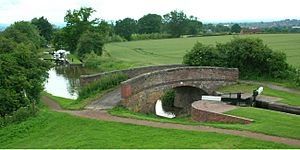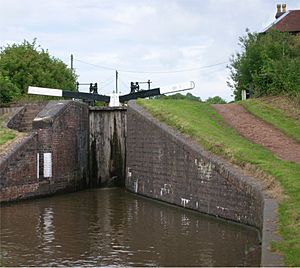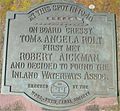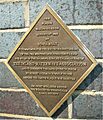Tardebigge Locks facts for kids
The Tardebigge Locks are the longest set of locks in the United Kingdom. They are also known as the Tardebigge Flight. This amazing series of 30 narrow locks is found on a 2¼-mile stretch of the Worcester and Birmingham Canal in Tardebigge, Worcestershire.
The locks help boats climb or descend a total of 220 feet (about 67 meters). This section of the canal is located between the Tardebigge tunnel (which is 580 yards long) to the north and the Stoke Prior flight of six locks to the south. You can also find the historic Tardebigge Engine House along this part of the canal.
Contents
History of the Tardebigge Locks
The very top lock at Tardebigge is quite special. It lifts boats 11 feet (about 3.3 meters), which is a big climb for a single lock! This particular lock was built to replace an interesting experiment: a vertical boat lift.
The canal was first opened from Birmingham to a place called the Old Wharf by 1807. This part didn't need any locks. After the Old Wharf, the canal goes through the Tardebigge tunnel. This tunnel was dug through solid rock to reach the New Wharf, which is just above Lock 58, the highest lock in the flight.
The Experimental Boat Lift
The canal company was worried about how expensive it would be to build all 58 locks needed to take the canal down to the River Severn at Worcester. So, they tried something new!
A man named John Woodhouse invented the Tardebigge vertical boat lift. He paid for it himself, while the canal company helped with digging and building. It was finished in 1808. This lift was housed in a covered shed and used heavy bricks as a counterweight. These bricks were connected by eight chains and pulleys. Two men would use a windlass (a type of crank) to operate it.
The lift had a large wooden chamber, called a caisson, that weighed 64 tons. This chamber was sealed at each end by gates that slid up and down, just like the lock chamber itself. The lift worked well, moving 110 boats in 12 hours! However, it was thought to be too delicate for everyday use. So, the rest of the canal was built with traditional locks, and the lift was replaced by a new lock in 1815. The lift mechanism is gone now, but you can still see where its balancing pit was, near the lock keeper's cottage.
The Tardebigge Engine House
Near lock number 57, which is the second lock from the top, you'll find the Tardebigge Engine House. This building was made to pump water up from Tardebigge Reservoir. The reservoir is about 50 feet (15 meters) below the level of the top part of the canal.
The original steam engine that did the pumping has been removed. Over the years, the building has been used for different things, like a restaurant and a nightclub. In 2012, it was turned into four homes. The reservoir was one of several places that supplied water to the canal.
In 1992, Lock 58 and some nearby structures, like the lock cottage and bridge, were given special protection as listed buildings. This means they are important historical buildings.
Inland Waterways Association
At the very top lock, you can see plaques that remember the founding of the Inland Waterways Association (IWA) in 1945. The IWA is a charity that works to protect and improve the canals and rivers of the UK.
-
Inland Waterways Association plaques at Tardebigge top lock






